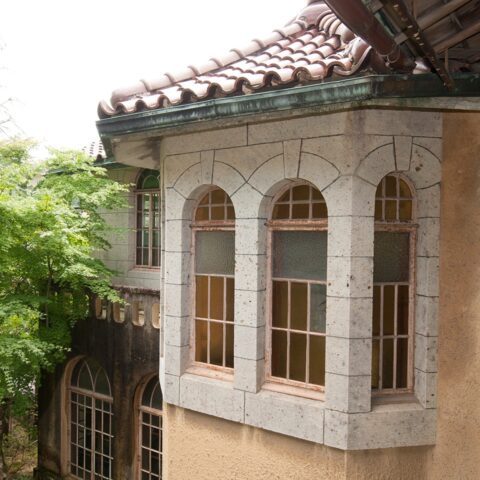Greeting
On behalf of Notre Dame Jogakuin, I would like to express our sincere appreciation to the participating world-class artists for coming together at our Wachu-an for the “Soko-kai x Wachu-an in Shishigatani” exhibition.
Throughout its long history, the building has gone through significant change. From its beginnings as the residence of an Omi merchant, it retained its sense of the Taisho era (1912-26) when it was later transformed into a convent for the American nuns, School Sisters of Notre Dame, who came to Japan with a passion for mission after World War II.
As such, it has been honored by many people as the treasure of Notre Dame Jogakuin. Ranging from pottery, Urushi art, dyeing, and glass art to metal and gemstone work, we are delighted to be bringing a collection of masterpieces together in our Wachu-an, thereby creating a special art universe filled with magnificent and delicate beauty. We hope you will enjoy a relaxing escape into art in the mid-autumn tranquility of Shishigatani.
Yoshiko Kurimoto, Chancellor, Notre Dame Jogakuin
It’s been more than 30 years since its establishment of Soko-kai in 1989. Over the years, we have organized exhibitions every single year challenging and exhibiting new world of kogei which no one else can do.
We are very happy to have this opportunity to hold an exhibition and show our kogei artworks at this unique and historic Wachu-an of the Notre Dame Jogakuin
We also hope to introduce the beauty and excellence of Kogei Art to the younger generations through hosting seminars and workshops for students at the Notre Dame Jogakuin.
Shoukoh Kobayashi, representative , Soko-kai
about Wachuan
Wachu-an, a sumptuous mansion with a large garden at the foot of Shishigatani, was built by Hikoshiro Fujii, a merchant from Omi district and a pioneer in the Japanese chemical fiber market. It was acquired by the School Sisters of Notre Dame in 1949. After being renovated and used as a convent, it was transferred to the Notre Dame Jogakuin Junior and Senior High School in 2008.
Uzan Nagao, a sinologist and friend of Fujii, named Wachu-an from his motto — “be fair and unbiased”. The view to the west from Wachu-an is superb, in part because the foot of the mountain had previously been cleared. Moreover, the water flowing from the east side of the mountain is pure and constant. Next to the large teahouse is a tall, wild cherry blossom tree called Edohigan, after which the town of Sakuradani was named, and which used to bloom beautifully every spring.
The Western-style part at the front of the building is Spanish-themed architecture with a beautiful parquet floor and ceiling. The annex (Shoin-style guest house), connected by a corridor, incorporates Sukiya-style design for the decorative transom and alcove ceiling. Fujii himself was involved in the design of this magnificent architecture.
〒603-8123 110 Shishigatani Sakuradani-cho, Sakyo-ku, Kyoto
TEL:075-771-0570(代)
FAX:075-752-1087
about Soko-kai
工芸美術創工会は1987年(昭和62年)に京都を中心とする関西・中国地区在住の工芸作家により結成されました。
平成元年(1989年)に京都府京都文化博物館の開館と時を同じくして第1回展を開催し、以後、京都の長い歴史や思想に育まれた工芸美術の伝統と革新を踏まえて、作家個々の新しい発想や創意を尊重し次代の工芸美術をリードする自由でリベラルな創作工芸美術集団として毎年発表を続けて参りました。
結成以来、日展をはじめ全国の公募展に多くの入選者、受賞者、審査員を排出し、近年は文化勲章受章者、文化功労者、日本藝術院会員、日本藝術院賞受賞者、内閣総理大臣賞受賞者、文部科学大臣賞受賞者、京都府文化功労者顕彰者、京都市文化功労者表彰者を輩出しています。
わが国の工芸は、日本の自然を感じる精神や風土に磨かれた美意識によって世界に誇る独自の発展を遂げて参りました。その長い時間をかけて築き上げられた創造の蓄積である伝統に我々が新たな創造を加え、人の心の根源的なものに訴えかける作品を発信し、今後も地域の芸術文化の発展と振興に寄与すべく活発な活動を続けて参ります。













